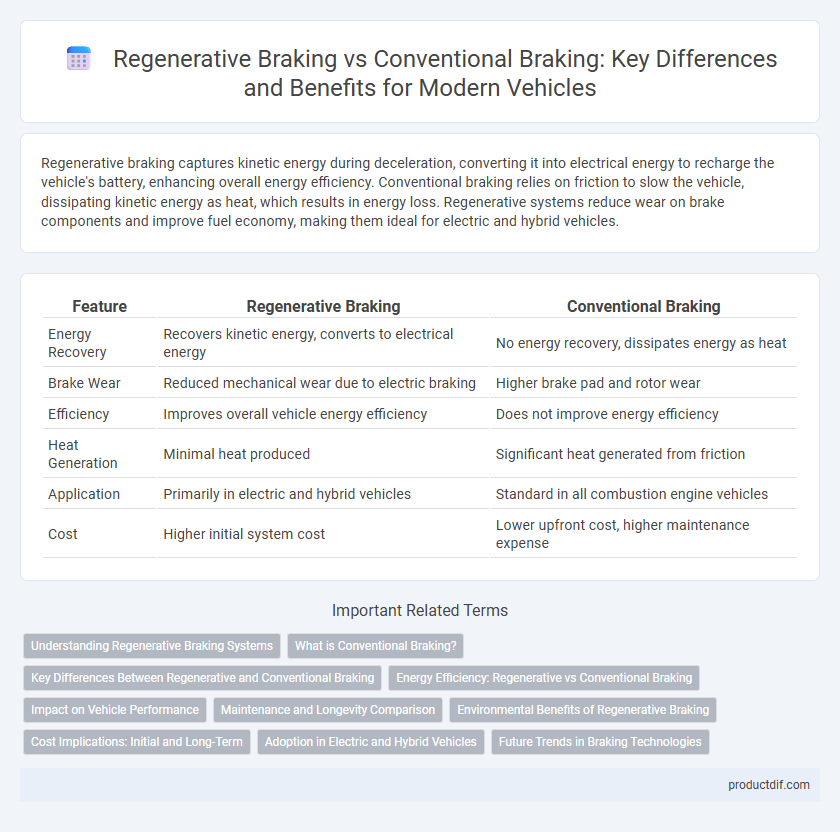Regenerative braking captures kinetic energy during deceleration, converting it into electrical energy to recharge the vehicle's battery, enhancing overall energy efficiency. Conventional braking relies on friction to slow the vehicle, dissipating kinetic energy as heat, which results in energy loss. Regenerative systems reduce wear on brake components and improve fuel economy, making them ideal for electric and hybrid vehicles.
Table of Comparison
| Feature | Regenerative Braking | Conventional Braking |
|---|---|---|
| Energy Recovery | Recovers kinetic energy, converts to electrical energy | No energy recovery, dissipates energy as heat |
| Brake Wear | Reduced mechanical wear due to electric braking | Higher brake pad and rotor wear |
| Efficiency | Improves overall vehicle energy efficiency | Does not improve energy efficiency |
| Heat Generation | Minimal heat produced | Significant heat generated from friction |
| Application | Primarily in electric and hybrid vehicles | Standard in all combustion engine vehicles |
| Cost | Higher initial system cost | Lower upfront cost, higher maintenance expense |
Understanding Regenerative Braking Systems
Regenerative braking systems convert kinetic energy during deceleration into electrical energy, which is stored in the vehicle's battery for later use, enhancing overall energy efficiency. Unlike conventional braking that relies on friction to dissipate energy as heat, regenerative braking reduces wear on brake components and improves fuel economy in hybrid and electric vehicles. Key components include electric motors, inverters, and energy storage systems, enabling seamless energy recovery and contributing to sustainable vehicle performance.
What is Conventional Braking?
Conventional braking systems rely on friction to slow down or stop a vehicle by pressing brake pads against a rotating disc or drum. This friction converts the vehicle's kinetic energy into heat, which dissipates into the environment, resulting in energy loss. Unlike regenerative braking, conventional braking does not recover or reuse energy during deceleration.
Key Differences Between Regenerative and Conventional Braking
Regenerative braking captures kinetic energy during deceleration and converts it into electrical energy stored in the vehicle's battery, while conventional braking dissipates kinetic energy as heat through friction. Unlike conventional braking systems that rely solely on brake pads and rotors, regenerative braking systems use electric motors to slow the vehicle, reducing brake wear and enhancing energy efficiency. The integration of regenerative braking is prominent in electric and hybrid vehicles, significantly improving range and reducing fuel consumption compared to traditional braking methods.
Energy Efficiency: Regenerative vs Conventional Braking
Regenerative braking systems capture and convert kinetic energy into electrical energy during deceleration, significantly improving overall vehicle energy efficiency by reducing reliance on the conventional friction brakes. Conventional braking dissipates kinetic energy as heat, resulting in energy loss and decreased fuel economy. Vehicles equipped with regenerative braking experience enhanced energy recovery, leading to better battery life in electric vehicles and lower fuel consumption in hybrids.
Impact on Vehicle Performance
Regenerative braking improves vehicle performance by converting kinetic energy into electrical energy, enhancing energy efficiency and extending battery life in electric and hybrid vehicles. Conventional braking relies solely on friction to dissipate energy as heat, which reduces overall efficiency and causes faster wear on brake components. The integration of regenerative braking systems results in smoother deceleration and reduced brake maintenance, positively impacting vehicle longevity and fuel savings.
Maintenance and Longevity Comparison
Regenerative braking systems reduce wear on traditional brake components by using electric motors to decelerate the vehicle, significantly extending the lifespan of brake pads and rotors compared to conventional braking. Conventional braking relies solely on friction, resulting in faster deterioration and more frequent maintenance due to brake pad and disc wear. Vehicles equipped with regenerative braking typically experience lower maintenance costs and longer intervals between brake service, enhancing overall vehicle longevity.
Environmental Benefits of Regenerative Braking
Regenerative braking systems convert kinetic energy into electrical energy during deceleration, significantly reducing energy waste compared to conventional braking that dissipates energy as heat. This process decreases the reliance on fossil fuels by extending battery life and improving the efficiency of electric and hybrid vehicles. As a result, regenerative braking contributes to lower carbon emissions and reduced environmental impact, making it a crucial technology for sustainable transportation.
Cost Implications: Initial and Long-Term
Regenerative braking systems typically have higher initial costs due to advanced technology and integration with electric drivetrains, but they can reduce long-term expenses by decreasing brake pad wear and improving energy efficiency. Conventional braking systems tend to be cheaper upfront but incur higher maintenance and replacement costs over time. Evaluating cost implications requires considering the total lifecycle expenses, including energy savings and component durability.
Adoption in Electric and Hybrid Vehicles
Regenerative braking systems capture kinetic energy during deceleration and convert it into electrical energy, significantly enhancing the efficiency of electric and hybrid vehicles by extending their driving range. Conventional braking, relying on friction to slow the vehicle, dissipates energy as heat, leading to greater energy loss. The widespread adoption of regenerative braking in electric and hybrid models supports battery longevity and reduces overall energy consumption compared to traditional braking systems.
Future Trends in Braking Technologies
Future trends in braking technologies emphasize the integration of regenerative braking systems with advanced electronic control units to enhance energy recovery efficiency and reduce wear on conventional braking components. Innovations are focusing on combining regenerative braking with predictive algorithms and vehicle-to-everything (V2X) communication to optimize braking force distribution and improve safety. The convergence of electric and autonomous vehicle technologies will drive the widespread adoption of intelligent braking systems that dynamically balance energy recuperation and conventional braking for maximum performance.
Regenerative Braking vs Conventional Braking Infographic

 productdif.com
productdif.com